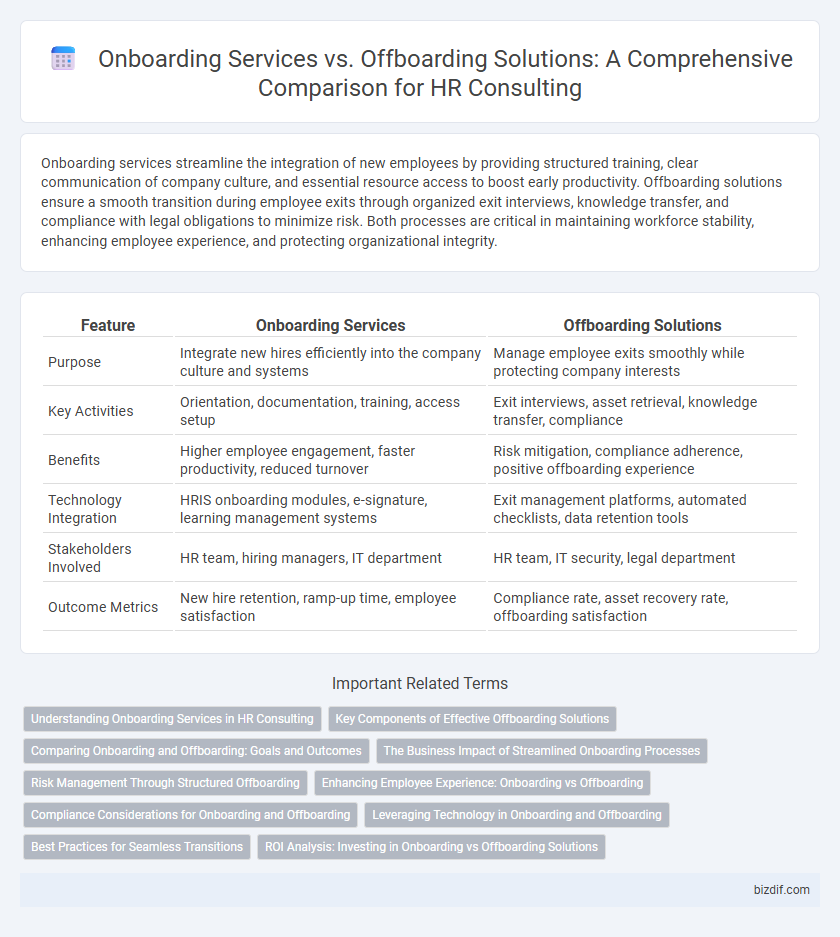Onboarding services streamline the integration of new employees by providing structured training, clear communication of company culture, and essential resource access to boost early productivity. Offboarding solutions ensure a smooth transition during employee exits through organized exit interviews, knowledge transfer, and compliance with legal obligations to minimize risk. Both processes are critical in maintaining workforce stability, enhancing employee experience, and protecting organizational integrity.
Table of Comparison
| Feature | Onboarding Services | Offboarding Solutions |
|---|---|---|
| Purpose | Integrate new hires efficiently into the company culture and systems | Manage employee exits smoothly while protecting company interests |
| Key Activities | Orientation, documentation, training, access setup | Exit interviews, asset retrieval, knowledge transfer, compliance |
| Benefits | Higher employee engagement, faster productivity, reduced turnover | Risk mitigation, compliance adherence, positive offboarding experience |
| Technology Integration | HRIS onboarding modules, e-signature, learning management systems | Exit management platforms, automated checklists, data retention tools |
| Stakeholders Involved | HR team, hiring managers, IT department | HR team, IT security, legal department |
| Outcome Metrics | New hire retention, ramp-up time, employee satisfaction | Compliance rate, asset recovery rate, offboarding satisfaction |
Understanding Onboarding Services in HR Consulting
Onboarding services in HR consulting streamline the integration of new hires by providing structured orientation, training, and compliance management to enhance employee engagement and productivity from day one. Effective onboarding reduces turnover rates and accelerates time-to-productivity by aligning new employees with company culture, policies, and role expectations. Tailored onboarding programs leverage data-driven insights to optimize employee experience and foster long-term retention.
Key Components of Effective Offboarding Solutions
Effective offboarding solutions encompass clear communication of exit procedures, thorough knowledge transfer, and compliance with legal and organizational policies. Key components include conducting exit interviews to gather valuable feedback, ensuring smooth data and asset retrieval, and providing support for employee transition and final settlements. Integrating these elements minimizes risks, maintains employer branding, and facilitates a positive offboarding experience.
Comparing Onboarding and Offboarding: Goals and Outcomes
Onboarding services aim to integrate new employees quickly and effectively, enhancing engagement, productivity, and retention by providing structured training, clear expectations, and cultural immersion. Offboarding solutions focus on ensuring smooth transitions through knowledge transfer, compliance with exit protocols, and maintaining positive employer branding, ultimately reducing legal risks and preserving organizational reputation. Comparing onboarding and offboarding reveals complementary goals: onboarding fosters workforce integration and growth, while offboarding safeguards operational continuity and protects company interests during employee departures.
The Business Impact of Streamlined Onboarding Processes
Streamlined onboarding processes significantly enhance employee productivity by reducing ramp-up time and increasing engagement from day one. Efficient onboarding decreases turnover rates, lowers recruitment costs, and fosters a positive employer brand that attracts top talent. Investing in comprehensive onboarding services leads to improved organizational performance and long-term business growth.
Risk Management Through Structured Offboarding
Structured offboarding solutions minimize legal and compliance risks by ensuring exit protocols align with company policies and regulatory requirements. They secure sensitive data, manage access revocation, and document employee departures to protect organizational assets. Effective offboarding reduces potential liabilities while maintaining positive employer reputation and operational continuity.
Enhancing Employee Experience: Onboarding vs Offboarding
Onboarding services streamline the integration of new hires by delivering personalized training, clear role expectations, and cultural immersion, boosting employee engagement and retention from day one. Offboarding solutions focus on exit interviews, knowledge transfer, and ensuring compliance, which preserve organizational knowledge and maintain positive employer branding. Both processes significantly enhance the overall employee experience by fostering trust and smooth transitions at critical employment stages.
Compliance Considerations for Onboarding and Offboarding
Compliance considerations for onboarding services include verifying employee eligibility, completing mandatory tax and employment forms, and adhering to industry-specific regulations such as OSHA or HIPAA. Offboarding solutions must ensure proper documentation of termination procedures, secure data handling to protect sensitive information, and compliance with final paycheck laws and benefits continuation (COBRA) requirements. Both processes require consistent adherence to labor laws and company policies to minimize legal risks and maintain regulatory compliance.
Leveraging Technology in Onboarding and Offboarding
Leveraging technology in onboarding enhances employee integration through automated workflows, digital document management, and interactive training platforms, improving efficiency and engagement. Offboarding solutions utilize secure data transfer, compliance tracking, and exit interview analytics to streamline processes and mitigate risks. Integrating advanced HR software ensures seamless transitions and optimizes workforce management in both onboarding and offboarding phases.
Best Practices for Seamless Transitions
Effective onboarding services establish clear communication, structured training programs, and personalized employee engagement to accelerate productivity and retention. Offboarding solutions emphasize thorough knowledge transfer, compliance adherence, and exit interviews to safeguard organizational knowledge and maintain positive alumni relations. Integrating these best practices ensures seamless transitions that enhance employee experience and optimize workforce continuity.
ROI Analysis: Investing in Onboarding vs Offboarding Solutions
Investing in onboarding services enhances employee productivity and retention, leading to an average 50% reduction in new hire turnover within the first year, which significantly improves ROI. Offboarding solutions mitigate risks by ensuring compliance, reducing legal costs, and preserving employer brand reputation, ultimately saving up to 30% in potential post-employment liabilities. Comparing ROI reveals onboarding yields long-term value through lower recruitment expenses, while offboarding secures financial stability by minimizing costly disputes and operational disruptions.
Onboarding Services vs Offboarding Solutions Infographic

 bizdif.com
bizdif.com